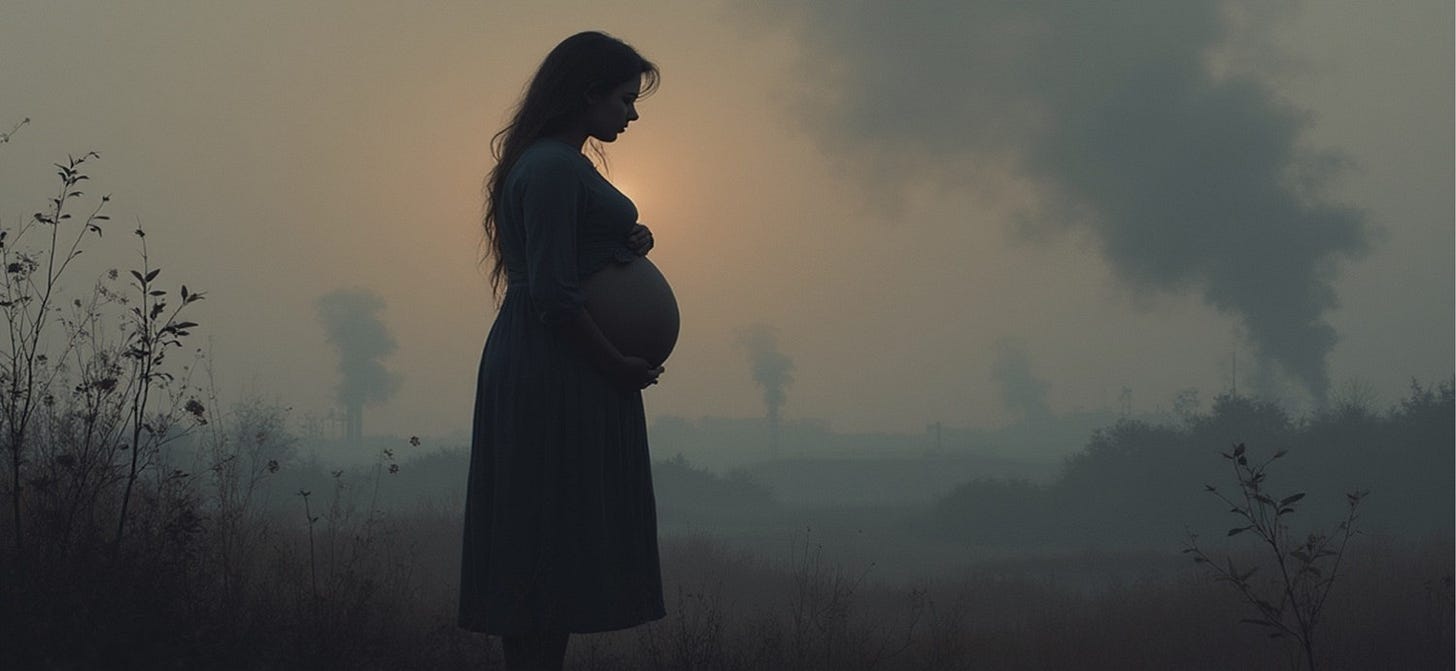Breathing for Two: Why India’s Air Pollution Fight Must Begin Before Birth
Dirty air doesn’t just choke cities; it shapes life chances before birth. Making clean air the country’s most powerful development investment.
View as PDF
Shashank Misra: Tilburg University, The Netherlands
Shobhit Kulshreshtha: Uppsala University, Sweden
SDG 3: Good Health and Well-Being | SDG 9: Sustainable Cities and Communities
Institutions: Ministry of Environment, Forest and Climate Change | Ministry of Health and Family Welfare
Air pollution is often spoken of in terms of smog-filled skylines and masked commuters. But its most profound impact occurs out of sight – in the womb. In India today, dirty air is insidiously shaping the health and potential of a generation before it even takes its first breath.
For a country whose demographic future is its greatest asset, this should sharpen our sense of urgency. The battle for clean air is not merely about environmental quality or urban planning; it is about protecting the foundations of life, health, and productivity.
The Unseen Origins of Harm
Fine particulate matter, PM2.5, is small enough to penetrate deep into the lungs and enter the bloodstream. When inhaled by expectant mothers, these particles can affect the placenta, slowing fetal growth and reducing birth weight. Short bursts of extreme exposure - common during winter smog spikes - can impair fetal growth even when annual pollution averages appear moderate.
Children born with lower birth weight face a higher risk of illness in infancy, slower cognitive development, and lower earnings as adults. Improving birth outcomes is therefore not just a health goal, it is an economic and social investment in India’s future human capital.
Analysis of individual-level data from two rounds of India’s National Family Health Survey (2015–16 and 2019–21), linked with satellite-based pollution measures at the district level, leads to a striking discovery. Mothers exposed to higher PM2.5 levels, about 16 micrograms per cubic metre (µg/m³) more than average, tend to have babies weighing roughly 40 grams less. The effect is about three times stronger than that observed in the United States or Italy.
Conversely, reducing pollution from current Indian averages (~40 µg/m³) to the World Health Organization’s guideline of 10 µg/m³ could raise average birth weight by around 80 grams and cut the prevalence of low-birth-weight births by more than 5 percentage points. Applied nationally, this translates into tens of thousands of healthier births each year - a gain comparable to major nutrition or maternal health interventions.
The Unequal Burden Of Pollution
Air pollution is distributed as unequally as wealth. Over 95 percent of India’s population lives in areas exceeding WHO limits. Within cities, poorer households live nearer to highways or factories and rely on polluting fuels like coal or firewood. The consequences fall hardest on those having fewest choices about where and how they live, and least equipped to mitigate them.
That means the children who are most affected are also those already facing disadvantage. Clean air, therefore, is a matter of justice as much as health. Environmental inequality reinforces social inequality, and any effective policy must take this intersection seriously.
The Economic Case for Clean Air
The same air that harms infants at birth also weakens the workforce and the economy that depend on them. The economic and moral cases for clean air are inseparable.
While the costs of inaction are high, the gains from cleaner air are even higher. A back-of-the-envelope calculation suggests that meeting WHO standards could yield over a billion dollars in annual productivity benefits - the equivalent of adding one-third of a state economy like Sikkim or Mizoram each year through cleaner air alone.
Moreover, global longitudinal studies show that each 100-gram increase in birth weight can measurably raise school attainment and test scores, with effects that compound across generations.
Seen this way, the price of reform is small compared with the cost of lost potential. Air quality management is not an environmental add-on; it is economic policy.
The Challenge is not Vision, but Implementation
Realising these gains depends less on new insight than on enforcing what already exists. India’s legal architecture for air quality management is strong on paper. The Air (Prevention and Control of Pollution) Act of 1981, the Right to Life (Article 21), and the State’s duty to protect the environment (Article 48A) create a firm constitutional foundation. Institutions like the Central Pollution Control Board (CPCB) and the National Green Tribunal (NGT) were established to enforce these mandates.
Yet enforcement remains weak. Monitoring systems are patchy, agencies under-staffed, and penalties inconsistently applied. Under the National Clean Air Programme (NCAP), launched in 2019 to cut particulate pollution by up to 30 percent in major cities, fewer than 40 percent of the 131 identified cities have shown consistent declines in PM2.5 levels. The problem lies less in policy design than in administrative capacity.
Crucially, policy must not only address average pollution levels but also the sharp, seasonal spikes that routinely push air quality into hazardous ranges. Targeted measures - from Delhi’s odd–even traffic restrictions to emerging interventions such as artificial rain — may not drastically lower annual averages, but they can stabilise exposure levels at critical times and deliver tangible health benefits for mothers and infants.
From Rulebooks and Punishment to Performance
Air-quality policy must shift from prescribing limits and punishing violations to measuring and rewarding results.
That means empowering pollution control boards with greater staffing, funding, and operational autonomy. It also means investing in real-time monitoring through affordable sensors and satellite data, and publishing results openly. Making air-quality data publicly available allows citizens and local governments alike to hold polluters accountable.
Transparency is particularly powerful in India’s federal system, where competition among cities can drive performance more effectively than central directives. International experience bears this out. In China, the public release of air-quality data spurred civic pressure and bureaucratic competition. Mexico City’s combination of fuel standards and open emissions reporting cut pollutants sharply within a decade. India can adapt these lessons to its own scale - recognising that pollution here inflicts greater harm not just because concentrations are higher, but because weaker maternal health and limited healthcare access leave mothers and infants more vulnerable.
Clean Air as A National Mission
Several of India’s policy moulds - from renewable energy to clean cooking fuel and digital governance - show that large-scale change is possible when state capacity, technology, and citizen participation align. Air-quality reform deserves a similar national mission approach.
Emerging technologies - from satellite monitoring to AI-based pollution tracking - can make regulation more precise and enforceable if embedded within accountable institutions. But technology must serve governance, not replace it.
Scientific evidence should guide not only diagnosis but design. Just as sanitation reform once followed epidemiological insight, air-quality improvement can evolve through data-driven policymaking.
India’s developmental story, human capital in particular, will depend on the air that sustains it. Protecting that air - for mothers, infants, and economy alike - may prove to be the country’s most productive reform.
Clean air is not a reward to be enjoyed after development is achieved; it is the very condition that makes development possible.
View as PDF
Authors:

The discussion in this article is based on the authors’ working paper on the subject. Views are personal.


